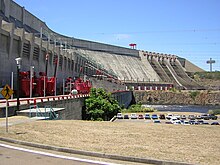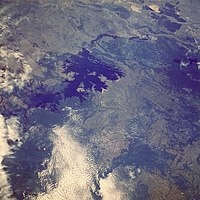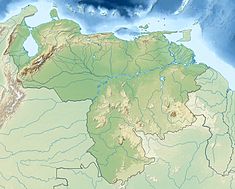Guri Dam
This article needs to be updated. (June 2016) |
| Guri Dam | |
|---|---|
 | |
| Official name | Central Hidroeléctrica Simón Bolívar |
| Location | Necuima Canyon, Bolívar |
| Status | In use |
| Construction began | 1963 |
| Opening date | 1978 |
| Owner(s) | CVG Electrificación del Caroní, C.A. |
| Dam and spillways | |
| Type of dam | Gravity/embankment |
| Impounds | Caroni River |
| Height | 162 m (531 ft) |
| Length | 7,426 m (24,364 ft) |
| Dam volume | Concrete: 6,026,000 m3 (212,806,182 cu ft) Earth: 23,801,000 m3 (840,524,383 cu ft) |
| Spillway type | Service, controlled crest overflow |
| Spillway capacity | 27,000 m3/s (953,496 cu ft/s) |
| Reservoir | |
| Creates | Guri Reservoir |
| Total capacity | 135,000,000,000 m3 (109,446,281 acre⋅ft) |
| Surface area | 4,250 km2 (1,641 sq mi) |
| Power Station | |
| Turbines | Francis Turbines.
10 × 730 MW 4 × 180 MW 3 × 400 MW 3 × 225 MW 1 × 340 MW [1][2] |
| Installed capacity | 10,235 MW |
| Annual generation | 47,000 GWh |
The Guri Dam is a concrete gravity and embankment dam in Bolívar State, Venezuela on the Caroni River built from 1963 to 1969.[3] It is 7,426 metres long and 162 m high.[4] It impounds the large Guri Reservoir (Embalse de Guri).[5] with a surface area of 4,250 square kilometres (1,641 sq mi)
History and design

In 1963, construction began for the hydroelectric power station Guri in the Necuima Canyon, about 100 kilometers upstream from the mouth of the Caroní River in the Orinoco. By 1969, a 106 m high and 690 m long dam with the official name of Central Hidroeléctrica Simón Bolívar (previously named Central Hidroeléctrica Raúl Leoni[citation needed] from 1978 to 2000) had been built. It created a reservoir which is the largest fresh water body of water in Venezuela and the eleventh largest man-made lake in the world[citation needed] with its water level at 215 metres above sea level. The power station had a combined installed capacity of 1750 megawatts (MW).[3] By 1978, the capacity had been upgraded to 2065 MW, generated by ten turbines.[citation needed]
Because the electricity demand grew so fast, 1976 saw the beginning of a second building stage: a 1300 m long gravity dam was built, another spillway channel and a second powerhouse containing 10 turbines of 630 MW each. The powerhouse´s inside walls were decorated by the Venezuelan kinetic artist Carlos Cruz-Díez.[citation needed] This increased the dam's dimensions to 162 m in height and to 7426 m (according to other sources 11,409 m[3]) in crest length. The water level rose to 272 m[6]: 12 and the reservoir grew in size and volume to a capacity of 138 billion cubic m for flood storage or floodwater evacuation.[3] The structure was inaugurated on 8 November 1986.[citation needed]
The total projected hydroelectric capacity is 10,300 megawatts, one of the largest in the world.
Since 2000, there is an ongoing refurbishment project to extend the operation of Guri Power Plant by 30 years. This project is to create 5 new runners and main components on Powerhouse II, and close to the end of 2007 is starting the rehabilitation of four units on Powerhouse I.[citation needed]
Ownership and financing
In 1978, C.V.G. Electrificación del Caroní, C.A.(EDELCA) awarded Hitachi the contract to install the 10 turbines of Phase 2. In 1985, Hitachi installed a computer system for the powerhouse for then owner C A E International; it also designed, manufactured and installed a monument called "Torre Solar".
In 1989 Hitachi installed baffles and draft tubes for twelve 730 MW units in Power House 2.[7] It did a major overhaul of 180 MW generating water turbine units number 1, 2 and 3 in Power House 1 and revamped guide rings on 730 MW generating units number 13 to 20 in Power House number 2 until 1993.[7]
From 1992 until 1997 C.V.G. Electrificación del Caroní, C.A.(EDELCA) revamped runner cones of 730 MW generating units in Power House 2, units 11, 13 until 20. From 1997 until 1998 Hitachi did a major overhaul of 223 MW generating water turbine units number 5 and 6 in Power House 1 and sent welders for repairs in runner vanes of unit 11 and 12. In 1998, EDELCA refurbished two floodgates, and from 1999 - 2001, it overhauled the 270 MW generating water turbine units number 4 and 7 in Power House 1.[7]
In 2000, EDELCA painted two metallic stairways located in earth preys. From 2002 - 2005 G.E. NORCAN Hydraulic Turbine Inc Proyecto Guri II (Venezuela) disassembled, refurbished and reassembled 5 units: During 2002, Mitsui de Venezuela, C.A. (for Toshiba) helped remove Unit 13 rotor blocks and EDELCA supplied steel for the extension of metallic lining of Unit 18's aspiration tube in Power House 2. Fromm 2002-2003, CVG rehabilitated valves and pipes of Unit 19's generator cooling system in Power House 2; Mitsui repaired and assembled the rotor of unit 13 and took corrective measures for the stator in Power House 2, while CVG rehabilitated valves and pipes of unit 13's generator cooling system.[7] During 2003, CVG machined holes of unit 19's stator base in Power House 2. From 2003-2004, Mitsui overhauled unit 17's generator in Power House 2. From 2004-2005, CVG rehabilitated the cooling system in units 14 and 17 in Power House 2. During 2006, CVG refurbished runners of units 16 and 20 and later 9. From 2006-2009, Alstom Hydro Venezuela S.A. worked on rehabilitation of an overhead crane in Power House 1 and 2 and other rehabilitation until 2011. From 2007-2008, CVG repaired runner blades of Unit 7.[7]
In 1988, Hitachi, Ltd founded affiliate company HPC Venezuela C.A (or VHPC), which stands for Hitachi Plant Engineering and Construction.[8]
Rankings
Guri Reservoir is one of the largest on earth. The hydroelectric power station ranks among the List of largest hydroelectric power stations. It was once the largest worldwide in terms of installed capacity, replacing Grand Coulee HPP, but was surpassed by Itaipu HPP.
Energy contribution
Due to government policy in effect from the 1960s to minimize power production from fossil fuels in order to export as much oil as possible, 74% of Venezuela's electricity comes from renewable energy like hydroelectric power.[6]: 33 As of 2006[update] the Guri Dam alone supplied more than a third of Venezuela's electricity[6]: 33 Parts of the power generated at Guri is exported to Colombia and Brazil.[6] The risks of this strategy became apparent in 2010, when, due to a prolonged drought, water levels were too low to produce enough electricity to meet demand.[citation needed] In January 2010, the Venezuelan government imposed rolling blackouts of two hours every day throughout the country to combat low water levels behind the dam due to drought.[citation needed]
In April 2016, water levels again became low, and the government announced blackouts of 4 hours per day, for 40 days or until water labels stabilized,[9] and government employees were told not to come to work on Fridays.
Environmental controversy
The dam has long been the focus of much controversy, because the lake it created forever destroyed thousands of square miles of a forest that was renowned for its biodiversity and rare wildlife, including the only place where the recently discovered Carrizal seedeater (a finch-like tanager) was ever found.[citation needed]
See also
- Energy policy of Venezuela
- List of largest power stations in the world
- List of conventional hydroelectric power stations
References
- ^ "Guri Hydropower Station". VHPC. Retrieved 25 March 2013.
- ^ "Hydroelectric Plants in Venezuela". IndustCards. Retrieved 8 November 2013.
- ^ a b c d "Guri Dam". Encyclopædia Britannica Online. Encyclopædia Britannica, Inc. 2011. Retrieved 29 August 2011.
- ^ "Dams - Guri". Covenpre VENCOLD. Retrieved 13 January 2011.
- ^ Farrell, John (23 February 1969). "A Dam And Falls In Venezuela Jungle". The Blade. Toledo, Ohio.
- ^ a b c d CVG Electrificación Del Caroní, C.A.: Cifras 2006, ISSN 1315-2386. Caracas, Agosto 2007
- ^ a b c d e "Performance Record: Summary of Performance Records". HPC Venezuela C.A. (VHPC). n.d. Retrieved 15 June 2016.
- ^ "Corporate Profile: Overview, Introduction of VHPC". HPC Venezuela C.A. n.d. Retrieved 15 June 2016.
- ^ "Venezuela Announces Daily 4-Hour Power Cuts Amid Drought". National Public Radio. 22 April 2016. Retrieved 5 May 2016.
External links
- EDELCA
- Erection Company on Guri HPC Venezuela C.A. (VHPC)

